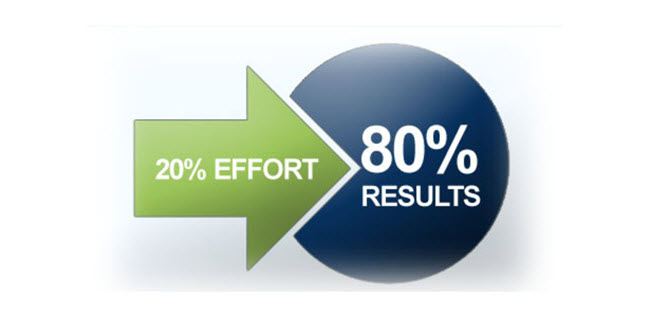The Pareto principle, also known as the 80/20 rule, is a theory maintaining that 80 percent of the output from a given situation or system is determined by 20 percent if the input. The principle doesn’t stipulate that all cases will demonstrate that precise ratio, it refers to a normal distribution. More generally, the principle can be interpreted to say that a minority of inputs results in the majority of outputs.
There are many situations where you are asked to decide which problems or causes of a problem should be tackled first. The Pareto principle also referred to as the 80-20 rule, states that roughly 80 percent of all the problems or effects come from 20 percent of the causes. It describes a statistical phenomenon that a small number of high values contribute more to the total than a huge number of low values. The focus of the Pareto Analysis is to identify the “vital few” from the “Trivial Many” and make it possible to attack the 80 percent of the problems to obtain the maximum benefits.
The exact percentages may vary in each situation. However, most of the activities is caused by relatively few of its factors. For example, 20 percent of car drivers cause 80 percent of the accidents, 20 percent of workers do 80 percent of the work, 20 percent of a company’s clients are responsible for 80 percent of its revenue, 20 percent of the time spend on a task leads to 80 percent of the results, 80 percent of the customer complaints come from 20 percent of the clients and 80 percent of the wealth belongs to 20 percent of the population.
The Pareto Principle is a great tool that can help to focus on what matters. It is used when we have many problems or projects and we want to concentrate on the most significant ones. It helps prioritize the improvement opportunities that bring the most value to the business and allows reaching a consensus about what needs to be addressed first. It is also used during continuous improvement projects to focus on the causes that contribute most to a particular effect and leads to prioritizing the potential causes of the problems being investigated.
Pareto did not coin the names Pareto Principle or 80/20 rule, but was credited to him by noted management expert Joseph M. Juran and others who became familiar with Pareto’s work and observations and determined that they could be applied to almost any problem or procedure and seem to always work out to the 80/20 ratio.
Examples of Where the Pareto Principle Is Used
- 80 percent of your profits will come from 20 percent of your product or services. The key is to identify which of those products and services are in the top 20 percent. Those are the products you never want to be out of and those are the services you want to improve on or expand continually. These services and products are the ones you want to advertise most heavily. You will want to be sure which of the remaining 80 percent of your products and services are really needed and that they support the top 20 percent.
- 80 percent of your sales will come from 20 percent of your costumers. After you have identified which of those costumers are in the top 20 percent, they are the ones you want to be sure are always catered to, they are always made aware of specials and ne products, that they are always given the opportunity to become repeat customers. These are the ones you want to solicit testimonials from.
- 80 percent of complaints will be generated based on 20 percent of your problems. Tracking your complaints will allow you to see and focus on the specific problem and areas that generate the most complaints. Finding those specific problems will allow you to identify and fix them. Of course, you should never stop tracking complaints because as soon as you fix one another will take its place as the main issue.
- 80 percent of your successful campaigns will come from 20 percent of your advertising. Identify your successful campaigns and duplicate or build on them. Use similar delivery methods for your message; some will work better than other with a particular audience. Knowing which methods and campaigns work will save you a lot of money in your advertising budget.
- 20 percent of your sales force will produce 80 percent of your sales. Nurture, grow and reward that top 20 percent, they are the superstars who will make your business successful. One of the attributes you will find in this group is that they will be the self starters who will always find a way to get the business. This will allow you to put more resources into developing the other 80 percent.
Conclusion
As stated earlier, the Pareto Principle or 80/20 rule rules work almost anyplace you apply it, the percentage will not always be exact 20 and 80, however the ratio will be very close. The Pareto Principle works with online as well as “brick & mortar” businesses. This is truly a common sense marketing tool that you should make part of your decision making and evaluating arsenal.






